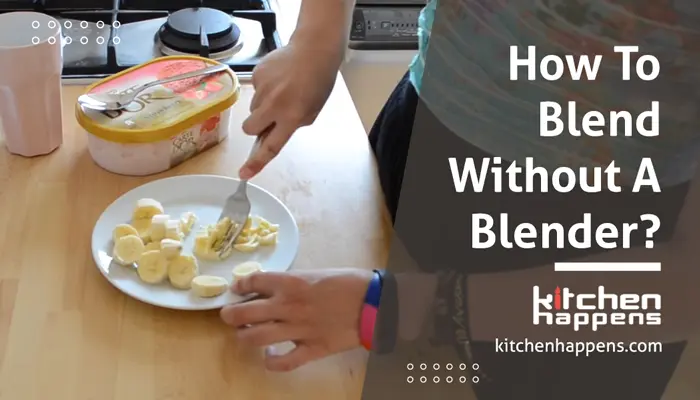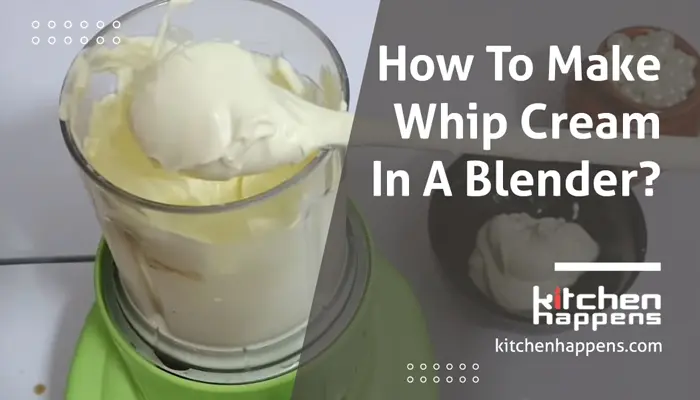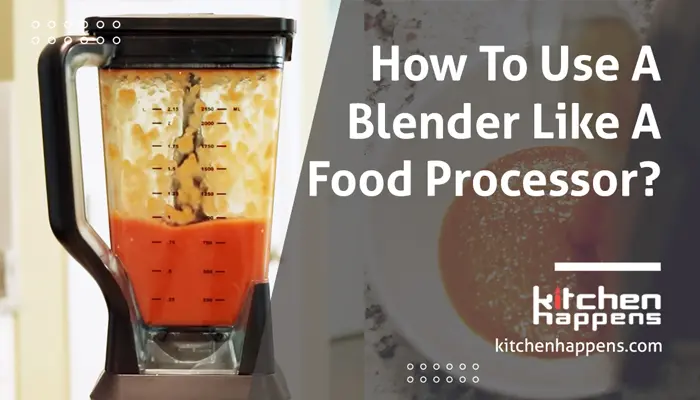In this modern age, a blender is a necessary kitchen appliance to have for everyday use. But what if you don’t have a blender for some reason and immediately need to blend something?
So, is there any way to blend without a blender? Well, the answer is yes, you can. You just need to spend some extra time and bring out your creativity.
Anyway, you don’t have to think much because today, I will let you know how to blend without a blender.
Now get ready to learn the techniques.
How to Blend Without A Blender: Necessary Tools & Techniques
The majority of the items we blend today were also pureed in the pre-technological age. While learning how to blend food without a blender, an essential factor to consider is the consistency that you want to achieve.
After that, you will be able to choose the right tools for blending your food. So, now I will share those alternative tools that you can easily find in your kitchen.
Note that using these tools may take longer time than a blender, but the end result is also great.
Alternative Tools for Blender
For different consistency, you will have to choose different kitchen appliances. Keep reading to know which tool is best for blending which food item.
1. Food Mill
A food mill can be your savior when you want to know how to puree without a blender. You can use food mills to mash and puree soft foods and vegetables manually.
It is operated by using a hand crank and a perforated plate that pushes the food items through it, turning choppy and coarse food into soft and smooth portions.
Whether you want to puree steamed vegetables, creamy soup or sauce, or make mashed potatoes, a food mill is an excellent alternative to consider.
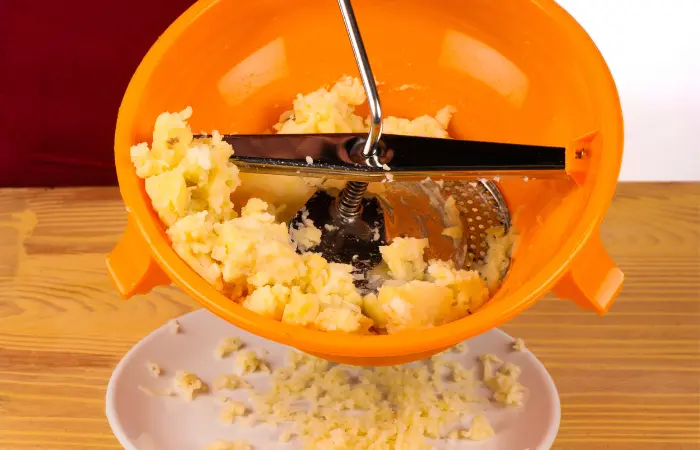
While working with hard vegetables, I suggest softening them by cooking them first. You can also make ground meats with a food mill.
However, this appliance isn’t ideal for blending raw meats. So, only use it for cooked meats.
2. Chinois Strainer
Since chinois strainers also feature perforated holes in which food is pushed through, they function very similarly to food mills.
The core difference between the two is that the food must be physically pushed through the slots of a chinois rather than being turned by a crank, as with a food mill.
If you have a chinois strainer, then you can easily make juice from soft fruits like tomatoes and puree food for soups without the help of a blender.
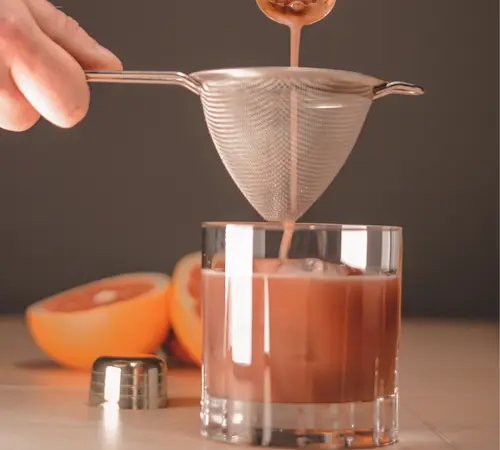
3. Chef’s Knife
There are some blender functions that can be done using a chef’s knife. However, it will take more time.
A chef’s knife is a great option when it comes to chopping and mincing hard and soft foods.
Whether you are looking for how to crush nuts without a blender or mince vegetables, it’s best to opt for a quality chef’s knife that is sharp enough to cut hard things.
But remember that it will only help blend selected items like fruits and vegetables.
Now follow the below steps to puree with a chef’s knife.
Step 1: Clean, peel, and prepare the ingredients you wish to purée first. After that, put them on a cutting board.
Step 2: Now, chop the chosen ingredients into small pieces using a chef’s knife that is both clean and sharp. Please take note that you must chop the foods using a rocking motion.
Step 3: After finishing the first two stages, take your chef’s knife and place it edge-side down in an almost flat but slightly angled position.
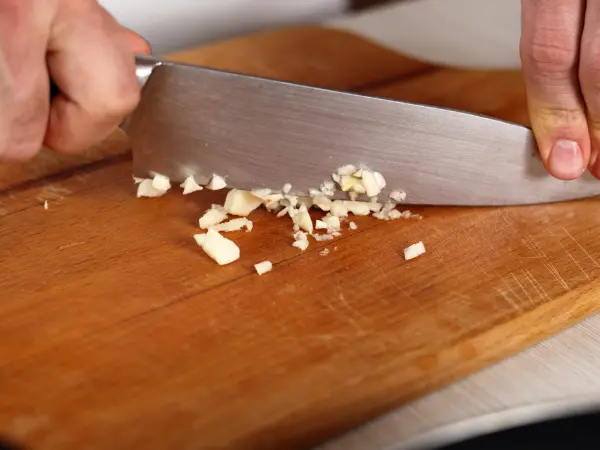
Step 4: Now, rock and drag the knife over the already cut foods with one hand on the knife and the other on the handle. Keep doing this repeatedly until you get a mush-like consistency.
4. Cheese Grater
Although it might seem strange, a cheese grater is useful for more than just grating cheese and peeling potatoes.
Numerous veggies, like zucchini, carrots, celery, onion, garlic, and fruit, can be finely chopped with cheese graters. They can be a great substitution for cutting up vegetables into lighter chunks.
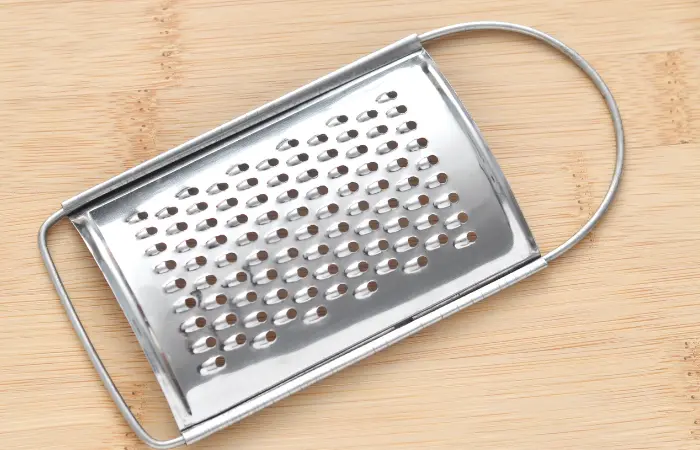
Just be cautious to keep an eye on your finger when handling small vegetables to prevent scratching them on the sharp edges.
5. Boiling Food And Mashing It with Fork
When you want to quickly break down your food, you can get blender-like results with a simple tool, a fork.
If the food item is hard, then consider boiling it in a saucepan for around 5 to 10 minutes. After that, use a fork to mash it up.
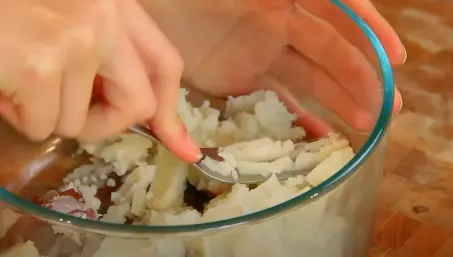
The fibers in the fruits or vegetables break when you boil them, making them super easy to mash with a fork. You can also consider using a potato masher.
If you prefer a smoother or finer texture, you might consider putting the mashed food through a sieve afterward.
6. Rolling Pin
Here is another alternative method when you need to break down hard foods into mashed consistency. For this, you will need a ziplock bag.
First, place the food inside the bag and place it on a flat surface or a cutting board. Then, slide the rolling pin back and forth over the ziplock bag until it reaches the desired consistency.
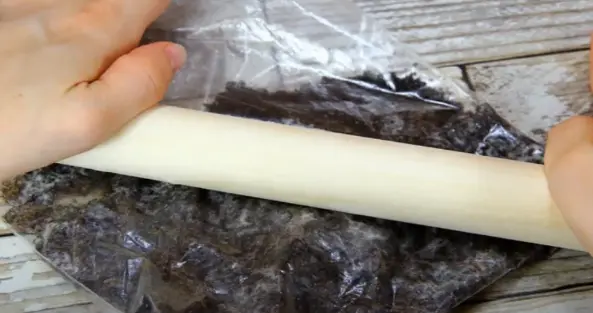
This method is perfect for breaking down cookies, biscuits, or bread for pie crusts.
For relatively harder food items, you will have to boil them to make them softer and then roll them to get mashed consistency.
7. Cheesecloth And Mallet
Another way to crush nuts, fruits, and vegetables is by using a cheesecloth and a mallet.
Note that this method will likely be one of the noisiest to do, but it surely gives you an effective result.
First, place your food items on a cutting board. Then, cover them with a large cheesecloth. Next, take the mallet and hammer the food. As you can guess, the cheesecloth will prevent food from splattering everywhere, so it’s necessary to use it.
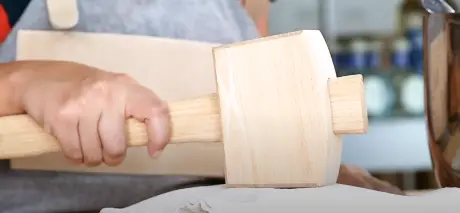
Anyway, keep hammering the food until they are crushed into smaller pieces.
Again I want to remind you that you can mash soft foods using this method, but if you have hard foods like squash or potatoes, cook them first.
8. Food Processor
Now obviously, there are many differences between a food processor and a blender as they are used for different purposes.
Foods are “blended” or combined by being ground up in a blender. In addition to pulverizing and combining, a food processor is capable of much more. It can chop, grate, slice, shred, and more.
Since a food processor has different types of blades and discs, it is excellent for chopping meats, fruits, and vegetables. You can also use it for whisking, whipping, and stirring.
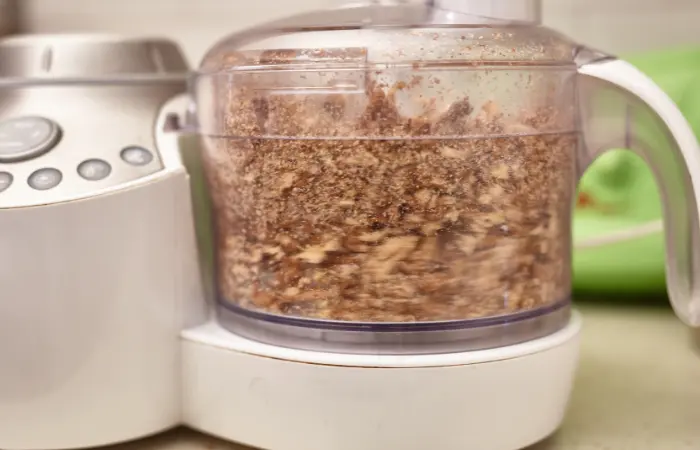
Remember that the end result in a food processor won’t be as runny as you get from a blender. However, it is indeed the best for chopping veggies for soups and salads, making breadcrumbs, and mixing food.
9. Immersion Blender
You may not have a classic blender, but if you have an immersion blender, it can help you do many of the blender’s functions.
An immersion blender is a versatile kitchen appliance that can quickly break down food.
Using an immersion blender, you can mix solid items with liquid to make dips, creams, and merengues. Also, you can blend soft vegetables for making soup, pasta, or other meals.
10. Potato Masher And Ricer
Now just because it is called a potato masher and a potato ricer doesn’t mean that you can only utilize it on potatoes.
It works with other soft food as well. So, if you want to mash something soft, you may also use a potato masher.
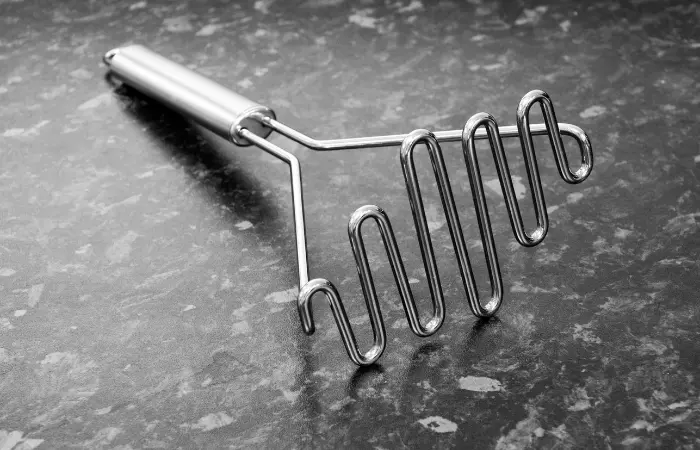
Till now, I talked about different tools that can be used as an alternative to a blender. But, most of their consistency is not exactly like you get from a blender.
But, if you use them one after another in a way, then you will get a similar texture. Hence, go through my instructions without any delay.
Instructions for Using Different Tools
Without a blender, there are numerous ways to combine various ingredients using the tools that I described. The technique I am going to share is effective for getting an almost blender-like result.
Step 1:
Start with your solid, hard ingredients (such as fruits, vegetables, nuts, seeds, and frozen fruits) and chop them as finely as you can with a knife. You can also crush them with a rolling pin or mortar and pestle or grate them with a grater, depending on the method that is best for that particular ingredient.
If you have a food processor, begin by pulverizing the dry ingredients. Next, add the additional hard components and blend to combine.
Step 2:
Chop any softer solid materials (such as soft, fresh fruits or vegetables) with a knife. For soft, fresh fruits, mash them with a masher or the tines of a fork. Add the chopped or mashed components to the remaining hard, solid ingredients.
Step 3:
Use a hand mixer, masher, fork, whisk, or other tool or appliance to mix in any additional soft, thick, or creamy components (such as yogurt or purees).
Step 4:
Add your liquid and combine everything together. You can use a hand mixture or an immersion blender.
Step 5:
Remove any lumps, seeds, or other impurities from the mixture by pushing it through a sieve with the back of a spoon to achieve a smooth blend.

Optional Step:
Pour it into a jar with a lid and give it a nice shake.
Anyway, the above instructions are described in a way to utilize different items for blending.
But, if you want to know about a specific recipe, like how to make strawberry juice without a blender or crush ice, my next segment has all your answers.
Making Different Food Items Without Using Blender
The most common item we make with a blender is the smoothie. So, I will discuss it first.
How to Make A Smoothie Bowl Without A Blender
Follow the below instructions to make a smoothie without a blender.
Step 1: Mash Soft Fruits Or Vegetables of Your Choice
First, grab a handful of soft fruits or vegetables to use. Make sure to choose the ripe ones so that they can break easily.
Some of the easiest fruit to work with are bananas, mango, pears, and kiwi. You may also use blueberries or raspberries.
Now take a mallet or potato masher to break the fruits down. If there are any larger chunks, mash them up finely.
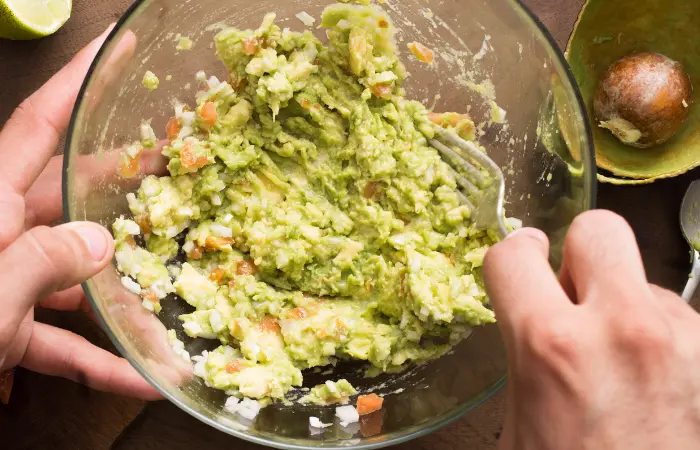
Another thing is that if you don’t like any small chunks of fruit in your smoothie, you may strain this mixture using a strainer.
Step 2: Add Protein Powder
Add protein powder to your meshed fruits or vegetables.
If you want a protein-free smoothie, you may skip this step.
You can also consider adding chia seeds, peanut butter, or yogurt to your smoothie. These items will enhance the taste.
By the way, before adding the protein to the smoothie, you might want to give it a quick taste test to make sure it isn’t too sweet, as it may significantly change how the drink tastes, especially if the protein contains peanut butter.
Step 3: Select The Best Liquid to Use
Next, you have to add a rich liquid to make your smoothie creamier. Milk, almond milk, rice milk, and soy milk are suitable liquids for the smoothie. You can choose any of them according to your preference.

You may also use coconut water or fruit juices like orange or apple juice. And if you want to keep the amount of sugar low, you may consider adding sugar-free soy milk or almond milk to the smoothie.
Step 4: Give All of These Items A nice Shake
Now take all of these blended items in a jar, cover it with a lid, and shake for a minute. Doing this will give the smoothie a foamy texture.
Then, pour in a glass and enjoy.
If you need a more detailed recipe for different types of smoothies, you may check our in-depth writing on how to make a smoothie without a blender.
Anyway, if you want to enjoy a cold smoothie, add some crushed ice. Check my next point to learn ice-crushing techniques without using a blender.
How to Crush Ice Without A Blender
For crushing ice, you can use the ziploc bag and rolling pin or cheesecloth and mallet technique.
But, the most effective will be using the zip lock bag and the mallet. First, place ice cubes inside it. Now hammer them using the mallet until all the ice cubes are crushed.
How to Make Strawberry Juice Without A Blender
Take 1 cup of ripe strawberry and wash it well with fresh water. After that, mash them using a potato masher or fork. You can also use an immersion blender if you have one.
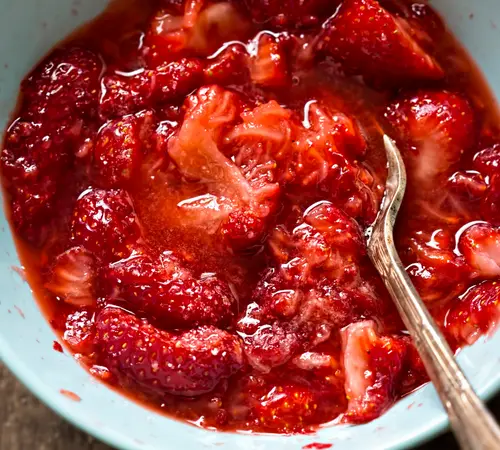
Once the strawberries are mashed well, add sugar as per your taste and whisk until sugar dissolves.
Next, you can add lemon juice if you want strawberry lemonade. Or, you can add cold milk if you like to have some strawberry milkshakes. After adding, again, whisk well.
If you like your juice to have small pulp, you can drink it as it is. But, if you don’t like it, then you may strain the juice with a strainer and enjoy.
How to Make A Frappuccino Without A Blender
Ingredients:
- 3 tablespoons of coffee powder
- 5 tablespoons of coffee mate
- 2 tablespoons of sugar
- 2/3 cup of water
- Salt
- Ice cubes
Directions:
Add the coffee powder, coffee mate, and sugar into a glass. Then pour water into it and stir with a spoon until everything dissolves. You may also learn how to make bulletproof coffee.
Next, place the ice cubes in a sealable container and sprinkle some salt over the cubes. Now take a ziplock bag or plastic food bag and pour the coffee mixture from the glass into it. Knot the bag and make sure the liquid isn’t leaking.
Then, put the bag inside the container with the ice cubes and close the lid. Shake the jar firmly for 2 to 3 minutes, or until all of the ice has melted.
After that, take out the bag, cut it, and pour it into a glass. Your frappuccino is ready to drink.
How to Make Milkshake Without A Blender
Ingredients:
- Milk
- Vanilla Ice cream
- Whipped cream (optional)
- Flavor of your choice (chocolate powder, cocoa powder, etc.)
Directions:
Take a mixing container with a lid or a drink shaker. Scoop your ice cream inside this jar and add milk.
Then, add any other ingredients that you like, such as mashed banana, chocolate powder, or other mashed fruits. Or, you can skip these if you don’t like to add anything.
Now stir the mixture well. Place the jar’s lid on top, then shake it vigorously for 15 to 20 seconds. Pour in a glass and drink. You may plop some whipped cream on top to make it more delicious.

How to Blend Soup Without A Blender
First, cook your vegetables until soft. Now, use a potato masher to squish the vegetables down into a pulp. You can also use a ricer to achieve the same result.
Another option is a food mill, which you can use to puree the vegetables. In this way, you will get pureed creamy soup.
Next, add whatever seasoning you like, such as salt, pepper, etc., to the pureed vegetable. If the mixture is too heavy, you may add some water to thin it down.
And if you want the consistency a bit thicker, you can add flour, reheat the mixture, and serve.
How to Make Coconut Milk Without A Blender
Ingredients:
- 2 cups of shredded coconut
- 4 cups of water
Directions:
Pour the water into a pot, place it on the stove and bring it to a boil, or until small bubbles form. When the water is ready, pour it into a bowl with shredded coconut and let it cool at room temperature.
After it cools down, knead the coconut using a clean hand for a minute.
Now, take a dampened cheesecloth and place it over another large bowl. Next, slowly pour the coconut mixture over the cheesecloth.
After that, grab the cheesecloth’s edges and squeeze the milk into the new bowl. Make sure to remove the juice from the coconut as much as possible.
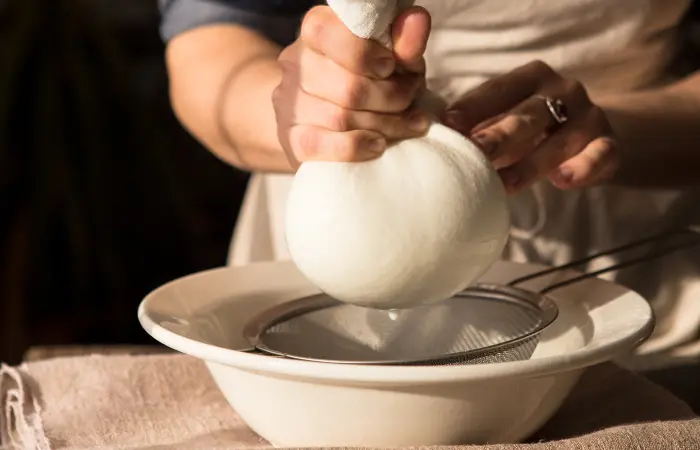
Pour the milk into a jar, and there you have your coconut milk.
How to Juice Ginger Without a Juicer Or Blender
Before juicing, wash and dry your ginger root. Peel your ginger root and trim any bruising if it is shriveled or discolored. But, if it is young and spotless, there is no need to peel it.
Then grate the ginger with a fine grater or a microplane. Using a cheesecloth, strain the grated ginger. Keep squeezing the cloth until you extract every drop of ginger.
And, here it is, your fresh ginger juice.
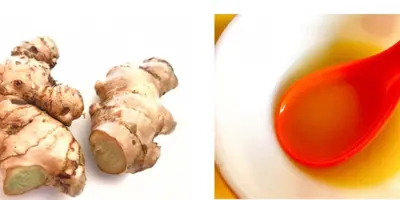
Alright, it’s time for my final words, as there’s nothing more to discuss.
Wrap Up Thoughts
After going through my detailed writing on how to blend without a blender, hopefully, you have no questions remaining in your mind that I didn’t answer.
I have presented many ways here. Now, whichever equipment you have in your kitchen, you can use it to blend your ingredients.
Lastly, have a good day!
Frequently Asked Questions
Can I puree with my hand?
Yes, you can puree certain foods like potatoes with your hand. You just need to boil the potatoes until they are soft. Then, cool them down and knead them with your hand. You can also use a fork.
Another way is using a mallet. Simply place the cooked vegetables inside a plastic bag and strike the mallet several times until everything is mashed.

